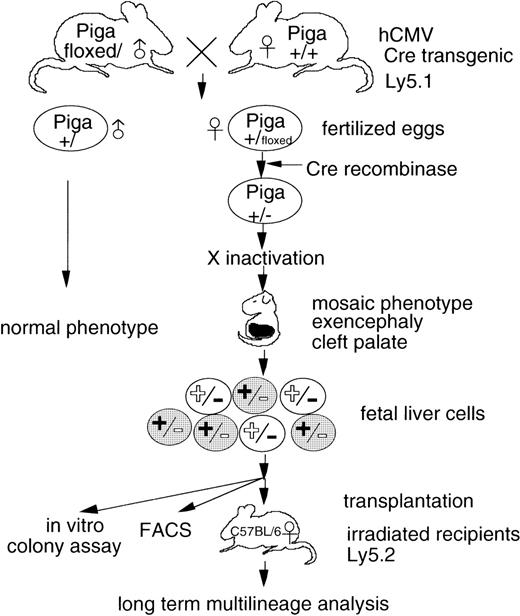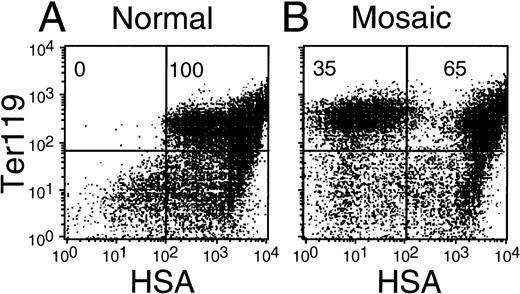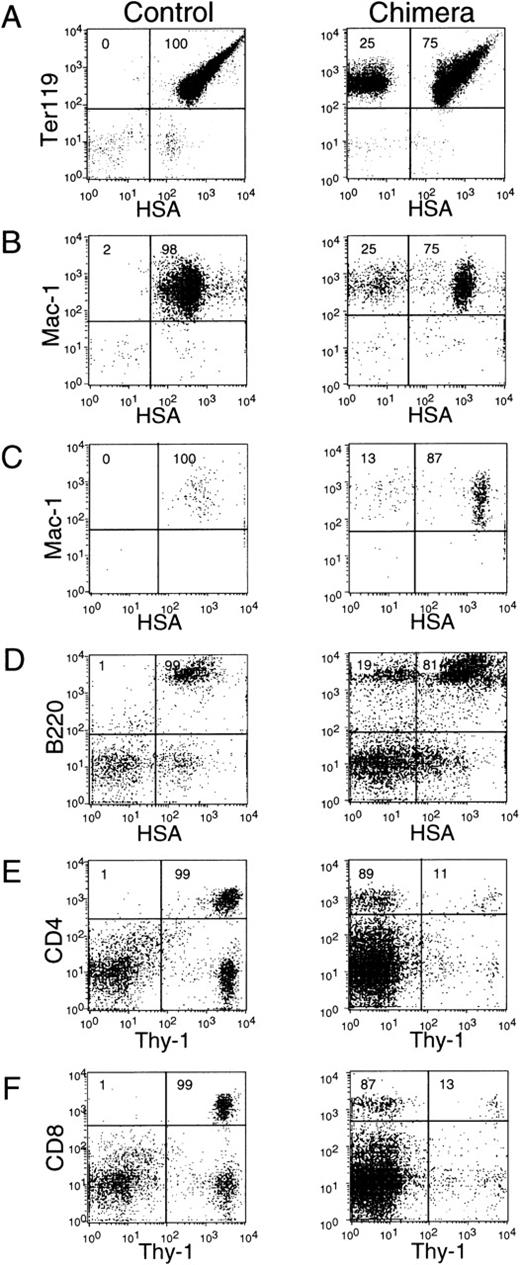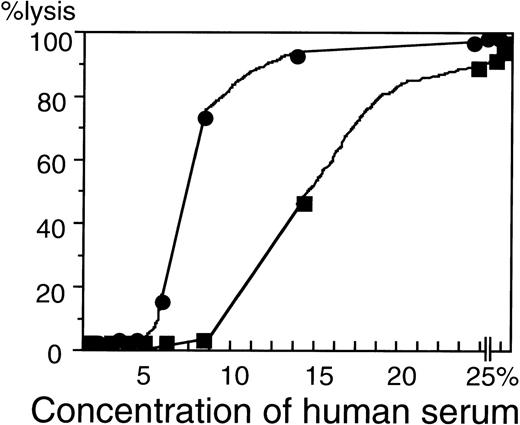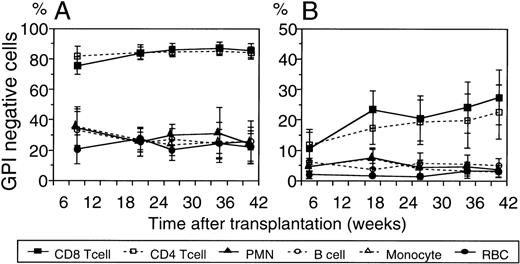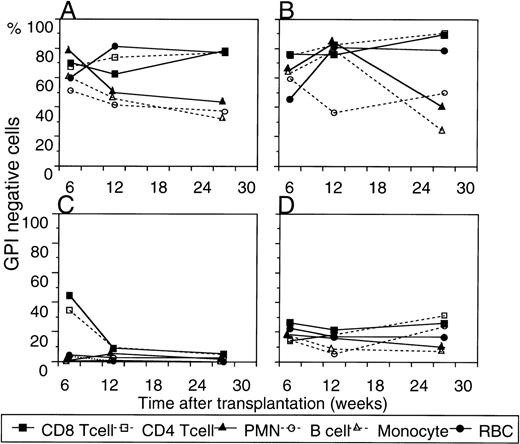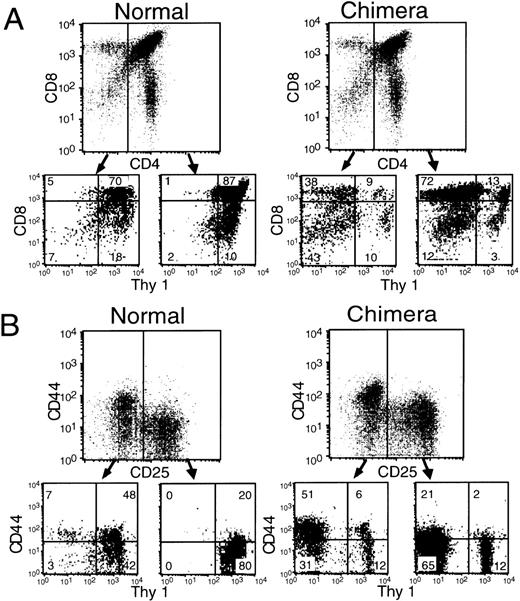Abstract
Patients with paroxysmal nocturnal hemoglobinuria (PNH) have one or a few clones of mutant hematopoietic stem cells defective in glycosylphosphatidylinositol (GPI) synthesis as a result of somatic mutation in the X-linked gene PIG-A. The mutant stem cell clone dominates hematopoiesis by a mechanism that is unclear. To test whether a lack of multiple GPI-anchored proteins results in dysregulation and expansion of stem cells, we generated mice in which GPI-anchor negative cells are present only in the hematopoietic system. We transplanted lethally irradiated mice with female fetal liver cells bearing one allele of the Piga gene disrupted by conditional gene targeting. Because of the X-chromosome inactivation, a significant fraction of the hematopoietic stem cells in fetal livers was GPI-anchor negative. In the transplanted mice, cells of all hematopoietic lineages contained GPI-anchor negative cells. The percentage of GPI-anchor negative cells was much higher in T lymphocytes including immature thymocytes than in other cell types, suggesting a regulatory role for GPI-anchored proteins at an early stage of T-lymphocyte development. However, the proportions of GPI-anchor negative cells in various blood cell lineages were stable over a period of 42 weeks, indicating thatPiga mutation alone does not account for the dominance of the mutant stem cells and that other phenotypic changes are involved in pathogenesis of PNH.
SOMATIC MUTATION and subsequent clonal expansion are critical events in the pathogenesis of somatically acquired genetic diseases. Paroxysmal nocturnal hemoglobinuria (PNH) is an acquired hematopoietic stem cell disorder associated with somatic mutation of the PIG-A gene,1-3 but the mechanism of clonal expansion has not been elucidated.4,5 PNH is characterized by intravascular hemolysis, venous thrombosis, and cytopenia caused by bone marrow failure.6,7 The defect lasts for many years. Patients with PNH have abnormal cells of various hematopoietic lineages that are defective in the biosynthesis of glycosylphosphatidylinositol (GPI), which serves as a membrane anchor for many cell surface proteins.8 The activation of the complement leads to the lysis of red blood cells deficient in the GPI-anchored proteins CD59 and CD55, which protect host cells from an attack by complement.8 9
The gene responsible for PNH, PIG-A, is involved in the first step of GPI anchor biosynthesis.1 In all patients reported to date, a somatic mutation occurred inPIG-A.2,3,10,11 It is hypothesized that this uniformity is caused by the X-linkage of PIG-A and autosomal localizations of all other GPI-synthesis genes,12-15because a single hit of somatic mutation is sufficient for knocking out an X-linked gene, whereas two hits are required for inactivation of autosomal genes.
Although a somatic mutation of PIG-A appears to occur in one or a few of the large number of pluripotent hematopoietic stem cells, GPI negative (GPI−) cells dominate in the bone marrow and the peripheral blood.8,16 Because affected stem cells are defective in the expression of various GPI-anchored proteins and because many GPI-anchored proteins are involved in cell-to-cell or cell-to-stroma interactions,8 GPI− stem cells might escape the negative regulation provided by the bone marrow environment, resulting in clonal dominance. To test whether GPI− stem cells have an intrinsic ability to expand, we17 and Rosti and colleagues18 disrupted the mouse Piga gene, a homologue of PIG-A, in embryonic stem cells and raised chimeric mice bearing GPI−cells. Because GPI-anchored proteins are essential for mouse development, mice with high chimerism did not survive to birth. Among the mice with low chimerism, only a few had GPI−blood cells. The analysis of this limited number of mice showed that percentages of GPI− red blood cells remained constant for several months to 1 year, suggesting that Piga mutation alone does not immediately cause the clonal dominance of GPI− stem cells. However, the chimeric mice had GPI− cells in nonhematopoietic tissues including bone marrow stromal cells, a situation different from that in patients with PNH. Moreover, because of embryonic lethality, it was practically very difficult to obtain a reasonable number of chimeric mice for analysis. To solve these problems, we have made chimeric mice bearing GPI− cells only of hematopoietic lineage by means of the Cre/loxP system and fetal liver transplantation.
MATERIALS AND METHODS
Generation of chimeric mice by transplantation ofPiga-disrupted hematopoietic stem cells.
Mice transgenic with human cytomegalovirus–Cre(hCMV-Cre) have been previously reported. A promoter of hCMV drives expression of Cre recombinase in most cell types beginning at the preimplantation stage.19 Mice with a Piga gene bearing loxP sites within intron 5 and the 3′ flanking region (termedPigaflox) were also reported previously.20 We crossed Pigaflox male mice with heterozygous or homozygous Cre transgenic female mice (Fig 1). Female embryos would receive thePigaflox allele that would become functionally inactive as a result of Cre-mediated elimination of exon 6. In contrast, males would be normal because Piga is X-linked. APiga-disrupted female embryo would be heterozygous forPiga disruption and would become mosaic of PIGA-expressing and PIGA-nonexpressing cells as a result of random X-inactivation (Fig 1). More than 70% of those female embryos showed abnormality in the cephalic portion. They died soon after birth or during development.21 We collected fetal liver cells of day 14 fetuses showing the morphological abnormalities and pooled them to transfer to the lethally irradiated C57BL/6 hosts (Fig 1). In some experiments, we used a portion of fetal liver cells for in vitro methylcellulose colony assay (see below), along with transplantation. To distinguish donor-derived cells from host-derived cells, we used mice whose Ly-5 allelic locus was 5.1 for the donor and 5.2 for the host.22
Generation of PNH model mice.Pigaflox male mice were crossed with heterozygous or homozygous Cre transgenic female mice.Piga-disrupted female embryos would be heterozygous forPiga disruption and would become mosaic of PIG-A–expressing and PIG-A–nonexpressing cells because of random X-inactivation. Fetal liver cells of 14 days post coitum (d.p.c.) fetuses showing the morphological abnormalities were collected and pooled to transfer to the lethally irradiated C57BL/6 hosts. Shaded cells indicate GPI− fetal liver cells bearing inactivated normal Piga allele (black+) and activated, disrupted-Piga allele (white−). Unshaded cells are GPI+ because of inactivation of disrupted-Pigaallele (black−). A portion of fetal liver cells was used for in vitro methylcellulose colony assay along with transplantation. To distinguish donor-derived cells from host-derived cells, mice with the Ly5.1 allele were used for the donors, and those with Ly5.2 were used for the hosts. Floxed indicates Piga allele bearing loxP sites.
Generation of PNH model mice.Pigaflox male mice were crossed with heterozygous or homozygous Cre transgenic female mice.Piga-disrupted female embryos would be heterozygous forPiga disruption and would become mosaic of PIG-A–expressing and PIG-A–nonexpressing cells because of random X-inactivation. Fetal liver cells of 14 days post coitum (d.p.c.) fetuses showing the morphological abnormalities were collected and pooled to transfer to the lethally irradiated C57BL/6 hosts. Shaded cells indicate GPI− fetal liver cells bearing inactivated normal Piga allele (black+) and activated, disrupted-Piga allele (white−). Unshaded cells are GPI+ because of inactivation of disrupted-Pigaallele (black−). A portion of fetal liver cells was used for in vitro methylcellulose colony assay along with transplantation. To distinguish donor-derived cells from host-derived cells, mice with the Ly5.1 allele were used for the donors, and those with Ly5.2 were used for the hosts. Floxed indicates Piga allele bearing loxP sites.
Antibodies.
FITC-conjugated anti-Ly5.1, -CD4, and -CD8; phycoerythrin (PE)-conjugated anti-Thy1.2, –heat stable antigen (HSA), and -CD25; biotinylated anti-CD44, -IAb, and -HSA; and alophycocyanin (APC)-conjugated anti-Thy1.2 and streptavidin were purchased from Pharmingen (San Diego, CA). Anti-B220 (RA3-6B2), anti-Mac-1 (M1/70), anti-CD4 (GK1.5), anti-CD8 (53-6.7), and anti-TER119 were purified from ascites of mice injected with each antibody-producing hybridoma (gifts from Dr T. Kina, Kyoto University, Kyoto, Japan) and biotinylated.
Fetal liver and bone marrow transplantations.
Single-cell suspensions were prepared from day 14 fetal livers and bone marrow in Dulbecco’s modified Eagle’s medium (DMEM). Six- to 9-month-old female C57BL/6 mice were lethally irradiated (900 cGy) by a137Cs source. On the same day, they were injected intravenously with 2 × 106 to 2 × 107 fetal liver cells or bone marrow cells suspended in 0.2 mL of DMEM. After injections, mice were maintained on aqueous antibiotics (103 U/mL of polymyxin B sulfate and 1 mg/mL of neomycin sulfate).
Methylcellulose colony assay.
Fetal liver and bone marrow cells (105) were plated in 1 mL of complete methylcellulose medium (MethoCult GF M3434; Stem Cell Technologies Inc, Vancouver, Canada). Hematopoietic colonies were identified according to the standard criteria.23 Granulocyte-erythroid-macrophage-megakaryocyte (GEMM) colonies were counted, picked up, and individually stained with PE-anti-HSA for flow cytometric analysis.
Flow cytometric analysis of the peripheral blood cells.
The contribution of GPI− cells to hematopoiesis in chimeric mice was assessed by fluorescence-activated cell sorting (FACS) analysis of the peripheral blood cells. For the analysis of red blood cells, we stained them first for a lineage marker with biotinylated anti-TER119, and second with a mixture of PE-anti-HSA and APC-streptavidin. For the three-color analysis of white blood cells, we stained them first with one of the biotinylated lineage-specific marker antibodies (anti-B220 for B lymphocytes, anti-Mac1 for granulocytes and monocytes, and anti-CD4 and anti-CD8 for T lymphocytes), and second with a mixture of a donor-specific antibody (fluorescein isothiocyanate (FITC)–conjugated anti-Ly5.1), PE-conjugated anti-GPI-linked surface antigen (anti-HSA for B lymphocytes, granulocytes, and monocytes, and anti-Thy1.2 for T lymphocytes), and APC-streptavidin, as a second-step reagent for the lineage markers. The stained cells were analyzed with a dual laser FACS caliber (Becton Dickinson, San Jose, CA).
Flow cytometric analysis of thymocytes.
Thymocytes were stained in four colors with biotinylated anti-Ly5.1 followed by a mixture of FITC-anti-CD4, APC-anti-CD8, PE-anti-Thy1.2, and a second-step reagent, peridinin chlorophyll protein (PerCP)-streptavidin. To study CD4,CD8 double negative cells, thymocytes were incubated with a mixture of biotinylated-anti-CD4, -anti-CD8, -anti-B220, and -anti-IAb, and negatively selected with streptavidin beads and a magnetic cell sorting (MACS) system. The unbound cells were further stained for four-color FACS analysis with biotinylated anti-CD44 followed by a mixture of FITC-anti-Ly5.1, PE-anti-CD25, APC-anti-Thy1.2, and PerCP-streptavidin.
Acidified serum lysis test.
To obtain GPI− red blood cells, peripheral blood cells sampled from a chimeric mouse were stained with biotinylated anti-HSA and subjected to a negative selection with streptavidin beads and a MACS system. GPI+ red blood cells were obtained from a chimeric mouse that was transplanted with fetal liver cells of aPiga-nondisrupted littermate. Erythrocytes (3 × 108) were washed three times and suspended in 1 mL of gelatin Veronal buffered saline.24 Human serum was acidified with a 10% volume of 2N HCl and serially diluted to 1 in 214 with gelatin Veronal buffered saline. A sample of 250 μL of each diluted serum was mixed with 25 μL of erythrocyte suspension and incubated for 1 hour at 37°C. For 100% lysis, water was used in place of serum, and for 0% lysis, heat-inactivated serum was used. After incubation, each sample was centrifuged, and the optical density of hemoglobin in the supernatant was measured at 412 nm.24
RESULTS
Generation of GPI-anchor deficient hematopoietic stem cells.
To study the characteristics of GPI− hematopoietic stem cells, we crossed Pigaflox males (bearing thePigaflox gene on the X-chromosome) with hCMV-Cre females (expressing Cre by means of the hCMV promoter) and prepared fetal liver cells from day 14 embryos. All TER119-positive liver cells from a morphologically normal embryo expressed GPI-anchored protein HSA (Fig 2A). In contrast, TER119-positive liver cells from morphologically abnormal female embryos were mosaic for the surface expression of HSA (Fig 2B), indicating that disruption of Piga occurred in the erythroid lineage. Percentages of HSA-negative cells varied among fetuses from 20% to 60%, presumably because of varying efficiencies of Cre-mediated Piga disruption or skewed X-chromosome inactivation or both. Because disruption of onePiga allele may have also occurred in the hematopoietic stem cells and in turn may have led, together with the X-chromosome inactivation, to a mosaic phenotype, we transplanted these fetal liver cells into lethally irradiated adult mice to compare characteristics of GPI− and GPI+ hematopoietic stem cells in vivo.
FACS analysis of fetal liver cells mosaic for the expression of GPI. A Pigaflox male mouse was crossed with hCMV-Cre female, and liver cells were prepared from day 14 embryos. (A) Liver cells from morphologically normal embryos. (B) Liver cells from morphologically abnormal female embryos. Fetal liver cells were stained for TER119 and HSA. Numbers in upper quadrants show percentages of HSA+ and HSA−TER+ cells.
FACS analysis of fetal liver cells mosaic for the expression of GPI. A Pigaflox male mouse was crossed with hCMV-Cre female, and liver cells were prepared from day 14 embryos. (A) Liver cells from morphologically normal embryos. (B) Liver cells from morphologically abnormal female embryos. Fetal liver cells were stained for TER119 and HSA. Numbers in upper quadrants show percentages of HSA+ and HSA−TER+ cells.
Generation of PNH model mice by transplantation of fetal liver cells mosaic for the expression of GPI.
After transplantation, we examined the peripheral blood cells every 6 to 12 weeks to see whether they contain GPI− cells. We stained them for three-color FACS analysis with antibodies to a donor marker Ly 5.1 (except for red blood cells), a lineage marker, and a GPI-anchored protein. Figure 3 shows FACS profiles of red blood cells and the Ly5.1-positive blood cells 34 weeks after transplantation. The surface expressions of marker GPI-anchored proteins were mosaic in red blood cells, granulocytes, monocytes, B cells, and CD4 and CD8 T cells from a mouse transplanted with mosaic fetal liver cells (Fig 3A-F, right panels), whereas they were positive in most of the corresponding cells from a control mouse transplanted with liver cells of a normal littermate embryo (Fig 3A-F, left panels). The GPI− cells were seen even at 42 weeks after transplantation (see below). These results indicated that GPI− hematopoietic stem cells with a long-term repopulating capability differentiated into various mature blood cells.
FACS profiles of the blood cells 34 weeks after transplantation. The peripheral blood cells were stained in three colors for Ly5.1 (except for red blood cells), a lineage marker, and a GPI-anchored protein. Except for red blood cells, cells were first gated by Ly5.1 expression. Right panels show the surface expressions of GPI-anchored proteins in various lineages of cells from a mouse transplanted with mosaic fetal liver cells. Left panels show those from a mouse transplanted with liver cells of a normal littermate embryo. (A) Erythrocytes stained for TER119 and HSA. (B) Granulocytes stained for Mac-1 and HSA. (C) Monocytes stained for Mac-1 and HSA. Granulocytes and monocytes were distinguished according to light scattering profiles. More than 99% of granulocytes and monocytes were Ly5.1-positive, donor-derived cells. (D) B cells stained for B220 and HSA. More than 99% of B cells were of donor origin. (E) CD4 T cells stained for CD4 and Thy1. Ninety-five percent of CD4 T cells were of donor origin. (F) CD8 T cells stained for CD8 and Thy1. Ninety percent of CD8 T cells were of donor origin.
FACS profiles of the blood cells 34 weeks after transplantation. The peripheral blood cells were stained in three colors for Ly5.1 (except for red blood cells), a lineage marker, and a GPI-anchored protein. Except for red blood cells, cells were first gated by Ly5.1 expression. Right panels show the surface expressions of GPI-anchored proteins in various lineages of cells from a mouse transplanted with mosaic fetal liver cells. Left panels show those from a mouse transplanted with liver cells of a normal littermate embryo. (A) Erythrocytes stained for TER119 and HSA. (B) Granulocytes stained for Mac-1 and HSA. (C) Monocytes stained for Mac-1 and HSA. Granulocytes and monocytes were distinguished according to light scattering profiles. More than 99% of granulocytes and monocytes were Ly5.1-positive, donor-derived cells. (D) B cells stained for B220 and HSA. More than 99% of B cells were of donor origin. (E) CD4 T cells stained for CD4 and Thy1. Ninety-five percent of CD4 T cells were of donor origin. (F) CD8 T cells stained for CD8 and Thy1. Ninety percent of CD8 T cells were of donor origin.
PNH patients suffer from hemolysis caused by a deficiency of complement regulatory GPI-anchored proteins. The chimeric mice had normal blood counts and had no such episodes. This may be because complement activity in mice, especially of the C57BL/6 strain, is low and because mouse erythrocytes have transmembrane complement regulatory molecules, such as Crry25 and transmembrane type decay-accelerating factor (DAF).26 GPI−erythrocytes were three times more sensitive to complement than GPI+ erythrocytes, as determined by the concentration of serum required for 50% lysis (Fig 4). It was reported that PNH erythrocytes with complete DAF/CD59-deficiency are 10 to 15 times more sensitive to complement than normal erythrocytes.27 This difference may be a result of the presence of transmembrane complement regulatory molecules on mouse erythrocytes.
Acidified serum lysis test. HSA+ (••) and HSA− (•) erythrocytes were incubated with acidified human serum, and percent lysis was determined.
Acidified serum lysis test. HSA+ (••) and HSA− (•) erythrocytes were incubated with acidified human serum, and percent lysis was determined.
GPI− hematopoietic stem cells have no intrinsic ability to dominate GPI+ cells.
Proportions of GPI− cells in red blood cells, granulocytes, monocytes, and B cells were usually similar (Fig 3A-D). They were much higher in CD4 and CD8 T cells (Fig 3E and F). These differences were not caused by experimental variations, because when more than 3 million fetal liver cells per mouse were transplanted into a group of mice, percentages of GPI− cells in a particular blood cell type were very similar among mice (Fig 5A). Under these conditions, hematopoiesis would have been reconstituted by the large number of hematopoietic stem cells that eliminated mouse-to-mouse variations. We monitored percentages of GPI− cells from 6 to 42 weeks after transplantation (Fig 5). Panel A in Fig 5 shows results for a group of six mice that received aliquots of the same pool of mosaic fetal liver cells. Percentages of GPI− cells changed little. Panel B in the same figure shows results for a group of 22 mice who received another pool of cells. In this case, liver cells from mosaic embryos were mixed with those from normal embryos to reduce proportions of GPI− cells. Again, percentages of GPI− cells changed little for up to 42 weeks in red blood cells, granulocytes, monocytes, and B cells. In T cells, percentages of GPI− cells slightly increased at the beginning, but were stable after 18 weeks. We performed seven other transplantation experiments using 40 recipient mice and obtained similar results. These results together indicate that GPI− hematopoietic stem cells did not have an intrinsic ability to dominate GPI+ cells.
Percentages of GPI− cells from 6 to 42 weeks after transplantation. (A) Mean percentages of GPI−cells in various blood cells from a group of six mice who received aliquots of the same pool of mosaic fetal liver cells. (B) Those from a group of 22 mice who received another pool of cells consisting of a mixture of mosaic and normal embryos. Bars indicate standard deviation (SD).
Percentages of GPI− cells from 6 to 42 weeks after transplantation. (A) Mean percentages of GPI−cells in various blood cells from a group of six mice who received aliquots of the same pool of mosaic fetal liver cells. (B) Those from a group of 22 mice who received another pool of cells consisting of a mixture of mosaic and normal embryos. Bars indicate standard deviation (SD).
When fewer numbers of fetal liver cells were transplanted, the result was different. Figure 6 shows the result with four mice that received 5 × 105 cells of the same cell pool. Percentages of GPI− cells varied among mice under these conditions, most likely because of the small number of transplanted hematopoietic stem cells. In two mice, percentages of GPI− cells were very high in various lineages (Fig 6A and B). Moreover, the percentage of GPI− cells varied with time in individual mice. In one of the mice, the proportion of GPI− monocytes was 80% at 12 weeks after transplantation, but was 20% at 30 weeks (Fig 6B). Therefore, when the number of hematopoietic stem cells was small, the contribution of each stem cell to hematopoiesis varied, and sometimes GPI− stem cells supported most of the hematopoiesis.
Percentages of GPI− cells in mice who received a smaller number of fetal liver cells. (A-D) Four mice who received 0.5 million cells of the same pool of mosaic fetal liver cells were monitored for up to 27 weeks after transplantation. Percentages of GPI− cells in various blood cells are shown. Percentages of Ly5.1-positive cells were higher than 90%.
Percentages of GPI− cells in mice who received a smaller number of fetal liver cells. (A-D) Four mice who received 0.5 million cells of the same pool of mosaic fetal liver cells were monitored for up to 27 weeks after transplantation. Percentages of GPI− cells in various blood cells are shown. Percentages of Ly5.1-positive cells were higher than 90%.
GPI-anchored proteins play roles early in T lymphopoiesis.
Because GPI− cells exceeded GPI+ cells in both peripheral blood CD4 and CD8 T lymphocytes, we analyzed T cells in lymph nodes and spleens. We found that proportions of GPI− cells in both CD4 and CD8 T lymphocytes in these lymphoid organs were similarly high (Table1), indicating that GPI− cells dominate entire compartments of mature CD4 and CD8 T lymphocytes.
To determine the stage of T-cell differentiation at which GPI− cells acquire dominance, we analyzed thymocytes of chimeric mice bearing GPI− cells. The numbers of thymocytes from mice bearing GPI− cells and normal mice were similar, and proportions of four populations defined by expressions of CD4 and CD8 were similar. In all four populations, the GPI− cell number was similarly high as in the peripheral T cells (Fig 7A), indicating that GPI− cells are already dominant at the CD4−, CD8− stage. Percentages of GPI− cells were similar in later developmental stages, namely CD4+, CD8+ cells and CD4 single and CD8 single positive cells. Therefore, GPI− cells developed to mature T cells at similar efficiency to GPI+cells.
Analysis of thymocytes from chimeric mice bearing GPI− cells. (A) Thymocytes were stained in four colors for Ly5.1, CD4, CD8, and Thy1. CD4+ and CD4− cells were separately examined for the expression of CD8 and Thy1. (B) The selected CD4,CD8 double negative thymocytes were further stained in four colors for Ly5.1, CD44, CD25, and Thy1. CD25+ and CD25− cells were separately examined for the expression of CD44 and Thy1.
Analysis of thymocytes from chimeric mice bearing GPI− cells. (A) Thymocytes were stained in four colors for Ly5.1, CD4, CD8, and Thy1. CD4+ and CD4− cells were separately examined for the expression of CD8 and Thy1. (B) The selected CD4,CD8 double negative thymocytes were further stained in four colors for Ly5.1, CD44, CD25, and Thy1. CD25+ and CD25− cells were separately examined for the expression of CD44 and Thy1.
To further dissect developmental stages within the CD4−, CD8− stage, we sorted CD4−, CD8− thymocytes and stained them with antibodies to CD44 and CD25 together with anti-Thy1. GPI− cells were already dominant in the most immature CD44+CD25− stage of thymocytes (Fig 7B). It seems, therefore, that GPI− cells become dominant at this stage within the thymus or before the lodging in thymus, or that a lack of GPI facilitates homing into the thymus.
GPI− B cells were very rare in the peripheral lymphoid organs.
We compared B lymphocytes in the peripheral blood and those in lymph nodes and spleens. Percentages of GPI− B lymphocytes were much lower in the peripheral lymphoid organs than in the peripheral blood (Table 1), suggesting that GPI− B lymphocytes have some difficulty in homing into these lymphoid tissues. This was unique to B lymphocytes because percentages of GPI− granulocytes and monocytes/macrophages were similar in the peripheral blood and spleen (data not shown).
Homing of the GPI− hematopoietic stem cells was as efficient as that of the GPI+ counterparts.
To test whether the lack of GPI-anchored proteins has any effect on the homing of the hematopoietic stem cells after transplantation, we recovered bone marrow cells from mice transplanted with mosaic fetal liver cells and retransplanted them into lethally irradiated mice. We determined percentages of GPI− cells in the peripheral blood of donor and recipient mice in the secondary transplantation. We also cultured the bone marrow cells in vitro to estimate the percentage of GPI− colony-forming units (CFU)-GEMM. Percentages of GPI−CFU-GEMM correlated well with those of GPI−granulocytes in the donor mice (Table 2). They also correlated well with those of GPI−granulocytes in the recipient mice (Table 2), indicating that GPI− and GPI+ hematopoietic stem cells have similar bone-marrow homing efficiencies.
DISCUSSION
We have established a mouse model to study the problem of clonal expansion of GPI− hematopoietic stem cells, a critical event in the pathogenesis of PNH. The model mimics PNH in two important ways. First, the mice generated in this study had GPI− cells only in the hematopoietic system. For this, we obtained GPI− hematopoietic stem cells from fetal livers by means of conditional gene knockout and transplanted them into lethally irradiated adult mice. Second, like patients with PNH, the mice bore GPI− and GPI+hematopoietic stem cells with exactly the same genetic background. As a source of hematopoietic stem cells for transplantation, we used female embryos in which one of the two alleles of the Piga gene was disrupted in the whole body. As a result of the X-chromosome inactivation, these embryos were mosaic for the expression of GPI-anchored proteins. Therefore, GPI− and GPI+ cells had exactly the same genetic background, the sole phenotypic difference being in the expression of GPI-anchored proteins.
Using these mice, we tested whether GPI−hematopoietic stem cells dominate GPI+ counterparts. Because proliferation of the hematopoietic stem cells may be regulated by interactions with bone marrow stromal cells through the cell surface proteins on the stem cells, we reasoned that GPI−hematopoietic stem cells might be more resistant to a negative regulation, leading to dysregulation and expansion. The results showed that this was not true because proportions of GPI−cells in various hematopoietic lineages were stable from 6 to 42 weeks after transplantation. Therefore, other events must occur to cause dominance of GPI− hematopoietic stem cells seen in PNH. It should be noted, however, that in this mouse model the hosts were irradiated before transplantation of a mixture of GPI− and GPI+ stem cells. If irradiation eliminates an expression of a molecule on bone marrow stromal cells that acts as a ligand of a relevant GPI-anchored protein on stem cells, then a critical regulatory interaction between the stem cells and the stromal cells might have been eliminated, preventing a possible expansion of GPI− stem cells. But it seems unlikely that irradiation causes such effects.
Although expansion of GPI− hematopoietic stem cells did not occur in the model mice when a large number of fetal liver cells (3 million) were transplanted, percentages of GPI− cells varied when a smaller number of fetal liver cells were transplanted. Under these conditions, the number of transplanted hematopoietic stem cells was small, a few or several, because percentages of GPI− cells were variable among mice. In one mouse, the proportion of GPI− monocytes was 80% at 12 weeks after transplantation and decreased to 20% at 30 weeks (Fig 6). We think that when hematopoiesis is maintained by a small number of stem cells, fluctuations can readily occur as the fractional contribution of any one stem cell is relatively great. This indicates that if the number of hematopoietic stem cells is decreased for some reason, the GPI− hematopoietic stem cells would contribute more to and account for most of the hematopoiesis. It is, therefore, implied that expansion of GPI−hematopoietic stem cells could occur as a consequence of a decrease in the number of hematopoietic stem cells.
Our results indicated that GPI-anchored proteins act early in T-lymphocyte development. Percentages of GPI− cells in peripheral blood CD4 and CD8 T lymphocytes were much higher than in other blood lineage cells. Percentages of GPI− cells were similarly higher in T lymphocytes in lymph nodes and spleen, eliminating the possibility that GPI− T lymphocytes are defective in the ability to home into lymphoid tissues from the blood. Therefore, GPI− cells dominated the entire fraction of mature CD4 and CD8 T lymphocytes. This indicated that GPI− cells became dominant during T-lymphocyte development. Within the thymus, the percentage of GPI− cells was already high in the most immature CD4 and CD8 double negative cells, and similar values were obtained for the CD4 and CD8 double positive cells, and both CD4 single and CD8 single positive cells. The GPI− immature T cells, therefore, developed into mature T lymphocytes at a similar efficiency to GPI+ cells. Further dissection and analysis of CD4 and CD8 double negative cells based on expressions of CD44 and CD25 showed that CD44-positive and CD25-negative cells, the most primitive thymic T lineage cells, contained a high percentage of GPI−cells. This indicated that GPI− cells were dominant at a very early stage in T-lymphocyte development. This domination may have occurred within the thymus, outside the thymus, or while entering the thymus. We think it is most likely that the domination occurred after the cells had entered the thymus. It is possible that some GPI-anchored proteins are involved in the negative regulation of cell proliferation, and their lacks result in the dysregulation of proliferation and expansion of GPI− cells. It was reported that CD44-positive and CD25-negative cells slowly proliferate and that active proliferation occurs in the subsequent CD44 and CD25 double positive stage before rearrangement of T-cell receptor (TCR) genes.28 If proliferation is not well-regulated at the CD44-positive and CD25-negative stage because of a lack of GPI-anchor, the percentage of GPI− cells would increase at this stage. While entering the thymus, T precursor cells would interact with other cells. Some GPI-anchored proteins might be involved in a specific interaction that facilitates the entrance of cells into the thymus. Therefore, GPI− cells would be less, rather than more, efficient at entering the thymus if GPI-anchored proteins play such a role. It is also unlikely that the domination exists in the prethymic common lymphocyte precursor cells because the domination was not seen in B lymphocytes. It is still possible, however, that the domination occurred after further commitment to the T-cell lineage, although such a prethymic stage has not been well characterized.
Four genes of GPI-anchored proteins expressed in T lineage cells, namely Thy1, Ly6A, CD24, and CD48, have been knocked out. None of them showed apparent abnormality in early T-cell development.29-32 It is possible that other GPI-anchored proteins are responsible or more than one of those four proteins are redundantly responsible.
In contrast with the mouse system, the percentage of GPI− cells in T lymphocytes from patients with PNH is no higher than in other cell types. This can be accounted for by the different role of thymus in the development of GPI− T lymphocytes in the model mice and patients with PNH. In patients with PNH, the thymus has usually already lost its function in T-lymphopoiesis when the somatic mutation of PIG-A occurred, whereas in the model mice, the thymus was actively involved in T-lymphopoiesis after transplantation.
The percentage of GPI− cells in the peripheral blood B lymphocytes was much lower than that in the T lymphocytes and similar to or lower than those in other blood cells, indicating that GPI-anchored proteins do not play a significant role in regulation during B-lymphocyte development. In contrast, the percentage of GPI− cells in lymph node and in spleen B lymphocytes was much lower than in the peripheral blood B lymphocytes. This indicates that some GPI-anchored proteins would be involved in either the entering of B lymphocytes into or keeping of them in the peripheral lymphoid organs. Therefore, GPI-anchors have different roles in T and B lymphocytes; they are important to the development of T lymphocytes but not B lymphocytes and to the homing of B lymphocytes but not T lymphocytes into lymphoid organs.
The important role GPI-anchored proteins play in the homing from blood to organs is unique to B lymphocytes. They do not seem to play a significant role in the homing of granulocytes and monocytes into lymph nodes and spleen, nor in the homing of hematopoietic stem cells into bone marrow. It is likely, therefore, that the roles of GPI-anchored proteins vary in cells of different lineages.
Studies with the model mice described here provided strong evidence that a second factor is involved in the expansion of GPI− hematopoietic stem cells in PNH. These mice should be useful to test candidates of the second factor for their ability to cause expansion of GPI− hematopoietic stem cells. Studies with these mice also provided evidence that GPI-anchored proteins play a role in the negative regulation of cell proliferation at an early stage of T-lymphopoiesis and are important for efficient homing of B lymphocytes into lymph nodes and spleen. Further studies are necessary to identify specific GPI-anchored proteins involved in these processes.
ACKNOWLEDGMENT
The authors thank Dr A. Nagy (Samuel Lunenfeld Research Institute, Toronto, Canada) for transgenic mice and Dr T. Iwabuchi (Hokkaido University, Sapporo, Japan) for discussions.
Supported by grants from the Ministry of Education, Science, Sports and Culture and the Ministry of Health and Welfare of Japan.
The publication costs of this article were defrayed in part by page charge payment. This article must therefore be hereby marked “advertisement” in accordance with 18 U.S.C. section 1734 solely to indicate this fact.
REFERENCES
Author notes
Address reprint requests to T. Kinoshita, PhD, Department of Immuno- regulation, Research Institute for Microbial Diseases, Osaka University, 3-1 Yamada-oka, Suita, Osaka 565-0871, Japan; e-mail: tkinoshi@biken.osaka-u.ac.jp.

